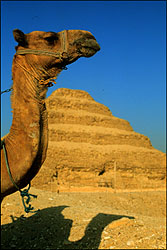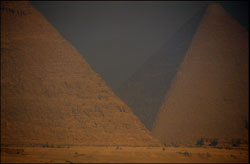
|
 The first pyramid was the Step Pyramid at Saqqara, built for King Zoser in 2750
BC. This first application of large scale technology, however, is often
attributed to Imhotep, the architect of the Step Pyramid. He was not a
pharaoh, but was the Director of Works of Upper and Lower Egypt. The
superstructure of the pyramid was made of small limestone blocks and desert
clay. Inside, the burial chamber and storage spaces for Zoser's grave goods
were carved out of the earth and rock beneath the structure. Imhotep's intent was
to mimic the basic structure of King Zoser's palatial home in the burial
chamber. The tomb, like those that followed, was meant to be a replica of the
royal palace. In early tombs, the central area was always the burial place. The
other surrounding rooms contained burial artifacts such as furniture and
jewelry and other provisions owned by the king. False doors of heavy stone,
inscribed with heiroglyphs, represented passageways between rooms. There were
no real doors between the rooms, because it was believed the king would be able
to move about his rooms, in the afterlife, without the help of structural
passageways. The first pyramid was the Step Pyramid at Saqqara, built for King Zoser in 2750
BC. This first application of large scale technology, however, is often
attributed to Imhotep, the architect of the Step Pyramid. He was not a
pharaoh, but was the Director of Works of Upper and Lower Egypt. The
superstructure of the pyramid was made of small limestone blocks and desert
clay. Inside, the burial chamber and storage spaces for Zoser's grave goods
were carved out of the earth and rock beneath the structure. Imhotep's intent was
to mimic the basic structure of King Zoser's palatial home in the burial
chamber. The tomb, like those that followed, was meant to be a replica of the
royal palace. In early tombs, the central area was always the burial place. The
other surrounding rooms contained burial artifacts such as furniture and
jewelry and other provisions owned by the king. False doors of heavy stone,
inscribed with heiroglyphs, represented passageways between rooms. There were
no real doors between the rooms, because it was believed the king would be able
to move about his rooms, in the afterlife, without the help of structural
passageways.
 It was only 150 years later, in the fourth dynasty of Egypt's Old Kingdom, that
King Khufu commissioned the building of the largest pyramid of all, the Great
Pyramid, which is the last remaining wonder of the Seven Wonders of the World.
It is thought that in 816 AD Caliph al-Mamun first ordered workers to blast
through the blocked stone entrance in order to explore within Khufu's pyramid.
But looters, probably from dynastic Egyptian times, had already absconded with
King Khufu's burial treasures and his body. This is true of all of the
pyramids at Giza, so very little is known about Khufu or any of his successors who
were buried at Giza. Archaeologists, nonetheless, continue to look for pieces
of this puzzle to further our understanding of the Pyramid Age and the pharaohs
that ruled Egypt. It was only 150 years later, in the fourth dynasty of Egypt's Old Kingdom, that
King Khufu commissioned the building of the largest pyramid of all, the Great
Pyramid, which is the last remaining wonder of the Seven Wonders of the World.
It is thought that in 816 AD Caliph al-Mamun first ordered workers to blast
through the blocked stone entrance in order to explore within Khufu's pyramid.
But looters, probably from dynastic Egyptian times, had already absconded with
King Khufu's burial treasures and his body. This is true of all of the
pyramids at Giza, so very little is known about Khufu or any of his successors who
were buried at Giza. Archaeologists, nonetheless, continue to look for pieces
of this puzzle to further our understanding of the Pyramid Age and the pharaohs
that ruled Egypt.
Follow a live excavation at Giza and join us in a visual exploration of Giza's
three pyramids and the Sphinx.
Photos: Aaron Strong
Pyramids Home | Pyramids | Excavation
Contents | Mail
|